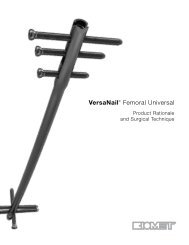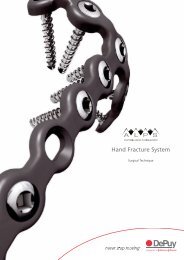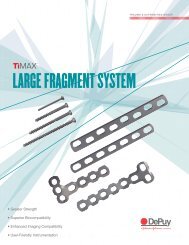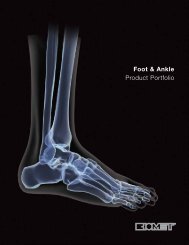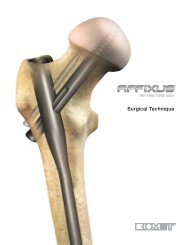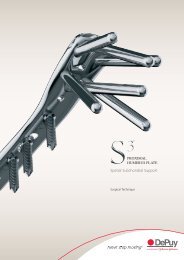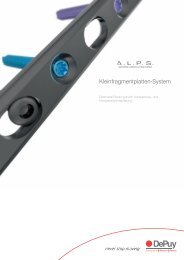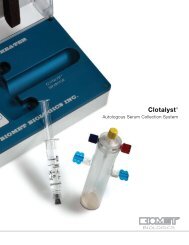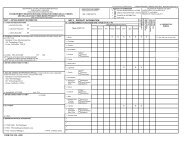VERSANAIL Tibial Nailing System Surgical Technique - Biomet
VERSANAIL Tibial Nailing System Surgical Technique - Biomet
VERSANAIL Tibial Nailing System Surgical Technique - Biomet
You also want an ePaper? Increase the reach of your titles
YUMPU automatically turns print PDFs into web optimized ePapers that Google loves.
Fig. 3<br />
Fig. 4<br />
Patient Positioning<br />
Position the patient supine on a radiolucent table (Fig. 3).<br />
Knee flexion will assist with identification of the anatomic<br />
landmarks to allow accurate incision placement. For ease of<br />
distal locking from the medial direction, it is helpful to place<br />
the C-arm on the opposite side of the injured limb.<br />
Entry Site and <strong>Surgical</strong> Approach<br />
Make a proximal incision along the medial aspect of the<br />
patellar tendon (Fig. 4). For more proximal fractures a lateral<br />
peri-tendinous approach may be beneficial based on surgeon<br />
preference. Continue deep dissection until the proximal<br />
aspect of the tibia is encountered.<br />
Fig. 5 A starting point is made either with a 3.6 mm x 14 in.<br />
guide pin (Cat. No. 2810-01-036) or an awl, based on<br />
surgeon preference (Fig. 5). Use AP and lateral fluoroscopic<br />
views to confirm accurate placement. For midshaft and distal<br />
tibia fractures, a central starting point in the AP view is<br />
adequate. For more proximal fractures, however, a slightly<br />
lateral starting point is recommended to avoid proximal<br />
fragment malalignment.<br />
Fig. 6 Use the awl (Cat. No. 2810-01-005) or 11.5 mm<br />
cannulated entry reamer (Cat. No. 2810-12-028) to open the<br />
proximal tibia. If required, an entry portal sleeve (Cat. No.<br />
2810-12-001) is available for soft tissue protection (Fig. 6).<br />
ENTRY AND CANAL PREP 3




